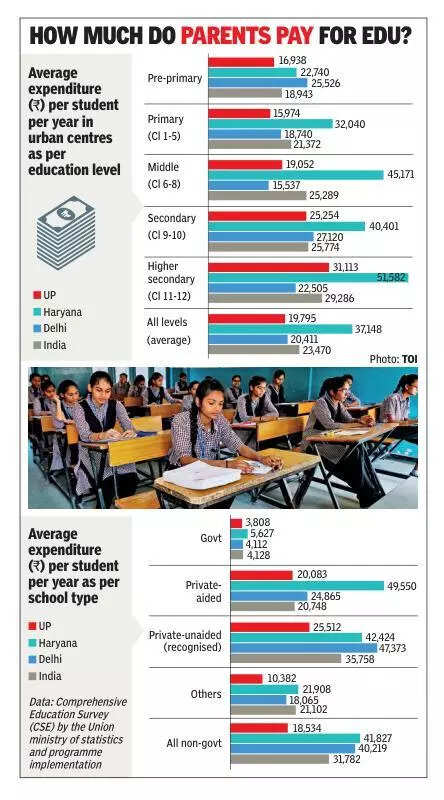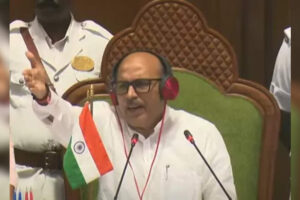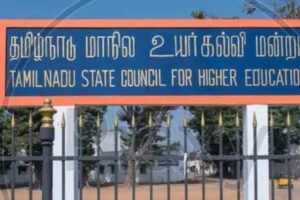
Gurgaon families shell out Rs 37,000 per child annually, Delhi Rs 20,000; check full list, ETEducation

GURGAON/NOIDA: School education is expensive in NCR but how much does it cost exactly?
It doesn’t fit into size, or in this case one bill, coming with wide variations in spending. It’s parents in Haryana’s urban areas like Gurgaon who shell out the most, nearly double compared to those in Delhi and UP.
On average, parents in Gurgaon — which has a bevy of international schools — and other Haryana cities spend an average Rs 37,148 per student annually, while parents in Delhi shell out Rs 20,411 and parents in Noida, Ghaziabad and other cities in UP spend Rs 19,795, shows the comprehensive education survey (CSE) released by the Union ministry of statistics and programme implementation.
The data reflects an average across types of schools. Several top-tier private schools in NCR charge up to Rs 3 lakh annually.
Of the average Rs 37,148 that parents in urban Haryana spend, course fee makes up Rs 24,838. Delhi follows with Rs 12,974 and UP with Rs 12,243.
Course fee includes charges under the heads of admission, tuition, examination fees, development fees and other compulsory payments. Transportation is another key expenditure head, with parents in Haryana’s urban areas spending an average of Rs 5,256 per year, followed by Delhi at Rs 3,210) and UP at Rs 2,077. Among other expenditure heads are stationery and uniform.
Spending across levels
The survey reveals stark contrasts across stages of school education. At the pre-primary level, urban families in Haryana spend Rs 22,740 annually, with boys’ education averaging Rs 25,183 and girls’ Rs 20,297. This is higher than both Delhi’s Rs 25,526 overall (Rs 23,596 per boy and Rs 28,317 per girl) and UP’s Rs 16,938 (Rs 18,598 per boy and Rs 14,989 per girl). Interestingly, Delhi’s rural spending pattern shows an unusual gender gap—parents spend nearly Rs 25,276 on girls annually, almost double the Rs 13,036 spent on boys.
At the primary level, Haryana’s urban spending average jumps to Rs 32,040 per student, more on boys (Rs 34,193) than girls (Rs 28,569). When rural spends are included, the state’s average stands at Rs 23,429. Delhi’s urban average at this level is Rs 18,740 (Rs 20,046 on boys and Rs 16,741 on girls), while UP lags at Rs 15,974 (Rs 15,322 on boys and Rs 16,192 on girls). The rural-urban combined average for Delhi is Rs 18,077, and for UP is Rs 8,727 per student.
The gap widens further at the middle level (classes V to 8). In Haryana’s urban centres, families spend Rs 45,171 per child, with girls’ education costing Rs 49,937 compared to boys’ Rs 40,584. This is significantly higher than what parents in Delhi (Rs 15,537 overall) spend on a boy at Rs 14,224 and a girl at Rs 17,832. In contrast, NCR cities in UP spend an average of Rs 19,052 (Rs 20,583 per boy and Rs 19,095 per girl) per student. Haryana’s average (Rs 29,983) is nearly three times UP’s (Rs 10,459) and well above Delhi’s combined Rs 15,682 when rural figures are included.
At the secondary stage, urban Haryana once again leads with Rs 40,401 per student, while Delhi parents spend Rs 27,120 and UP Rs 25,254 per student.
The findings underlined the unequal costs of schooling across NCR.
In Haryana, it’s likely that high school spends — both in terms of fees and associated costs — in places like Gurgaon are pulling up the urban average. While Delhi and UP families also feel the pinch, their spending is cushioned by the availability of cheaper options. Delhi in particular has a robust govt school network.
The annual survey covered all kinds of schools, including those with an average annual expenditure of Rs 2-4 lakh, to low expenditure schools with Rs 15,000-20,000 annual fees, as well as govt, private, and aided schools in specified urban or rural areas. The survey gathered detailed education-related information on 57,742 students, all currently enrolled in schools.
A total of 2,384 villages and 1,982 urban blocks were surveyed. In total, data was collected from 2.21 lakh people, including 1.26 lakh in rural centres and 95,538 in urban centres.
Source link



